Introduction Of Chinese Cabbage (Bok Choy)
Chinese cabbage, also known as bok choy or pak choi, is a leafy vegetable popular in Asian cuisine. It has dark green leaves and white stalks, with a mild flavour and crisp texture. Rich in vitamins, minerals, and antioxidants, Chinese cabbage is versatile and can be eaten raw in salads or cooked in stir-fries, soups, and other dishes. It thrives in cool weather and is widely cultivated in spring and fall. Chinese cabbage is prized for its health benefits, culinary versatility, and cultural significance in Asian cuisine.
Origin of Chinese Cabbage (Bok choy)
Chinese cabbage, commonly known as bok choy or pak choi, has its origins in China, where it has been cultivated for centuries. It is believed to have been domesticated from wild cabbage species native to the region. Over time, different varieties of Chinese cabbage have been developed through selective breeding, resulting in the diverse range of shapes, sizes, and flavours available today. Chinese cabbage is now widely grown and consumed in many Asian countries, as well as being popular in international cuisine.
Also Try: Bottle Gourd Delicacies to Relish
Health Benefits of Chinese Cabbage
Chinese cabbage, or bok choy, offers several health benefits:
- Nutrient-Rich: Chinese cabbage is low in calories but high in essential nutrients such as vitamins A, C, and K, folate, calcium, potassium, and manganese.
- Antioxidant Properties: It contains antioxidants like vitamin C and beta-carotene, which help protect cells from damage caused by harmful free radicals and reduce the risk of chronic diseases.
- Bone Health: Chinese cabbage is a good source of calcium and vitamin K, which are essential for bone health and may help reduce the risk of osteoporosis.
- Heart Health: The high potassium content in Chinese cabbage helps regulate blood pressure levels, reducing the risk of hypertension and heart disease.
- Digestive Health: With its high fibre content, Chinese cabbage supports digestive health by promoting regular bowel movements and preventing constipation.
- Immune Support: The vitamins and antioxidants in Chinese cabbage support a healthy immune system, helping the body fight off infections and illnesses.
- Hydration: Chinese cabbage has a high water content, making it hydrating and refreshing, especially during hot weather or after physical activity.
- Weight Management: Chinese cabbage is low in calories and high in fibre, making it a filling and satisfying food choice that can aid in weight management and promote feelings of fullness.
Incorporating Chinese cabbage into your diet can contribute to overall health and well-being, thanks to its nutrient density and various health-promoting properties.
Uses of Chinese Cabbage In Indian Kitchen
While Chinese cabbage, also known as bok choy or pak choi, is not traditionally a staple in Indian cuisine, it can still be incorporated into various dishes to add texture, flavour, and nutritional value. Here are some ways Chinese cabbage can be used in Indian cooking:
- Stir-Fries: Chinese cabbage can be added to stir-fries along with other vegetables and spices commonly used in Indian cooking. Its crisp texture and mild flavour make it a versatile addition to dishes like vegetable stir-fries or Indo-Chinese recipes.
- Curries: Chinese cabbage can be used in curries and gravies, where it absorbs the flavours of the spices and other ingredients. It can be added to traditional Indian curries such as mixed vegetable curry or paneer curry to enhance the texture and nutritional profile of the dish.
- Soups and Stews: Chinese cabbage can be added to soups and stews to add volume and nutrients. It works well in hearty soups like lentil soup or mixed vegetable soup, providing a refreshing crunch and mild sweetness.
- Salads: Chinese cabbage can be shredded and used in salads along with other vegetables, fruits, and nuts. It adds a crisp texture and freshness to salads, making them more filling and nutritious.
- Wraps and Rolls: Chinese cabbage leaves can be used as wraps or rolls for stuffing with various fillings such as cooked vegetables, paneer, or tofu. They can be steamed, baked, or pan-fried to make delicious and healthy appetizers or snacks.
- Pickles: Chinese cabbage can be pickled and preserved to be enjoyed as a condiment or side dish. It can be pickled with spices and vinegar or fermented to make kimchi, a popular Korean condiment that is also enjoyed in Indian cuisine.
While Chinese cabbage may not be a traditional ingredient in Indian kitchens, its versatility and nutritional benefits make it a valuable addition to a variety of Indian dishes, offering new flavours and textures to familiar recipes.
6 recipes using Chinese Cabbage
RECIPE 1] Stir-Fried Chinese Cabbage (Bok Choy Bhaji)
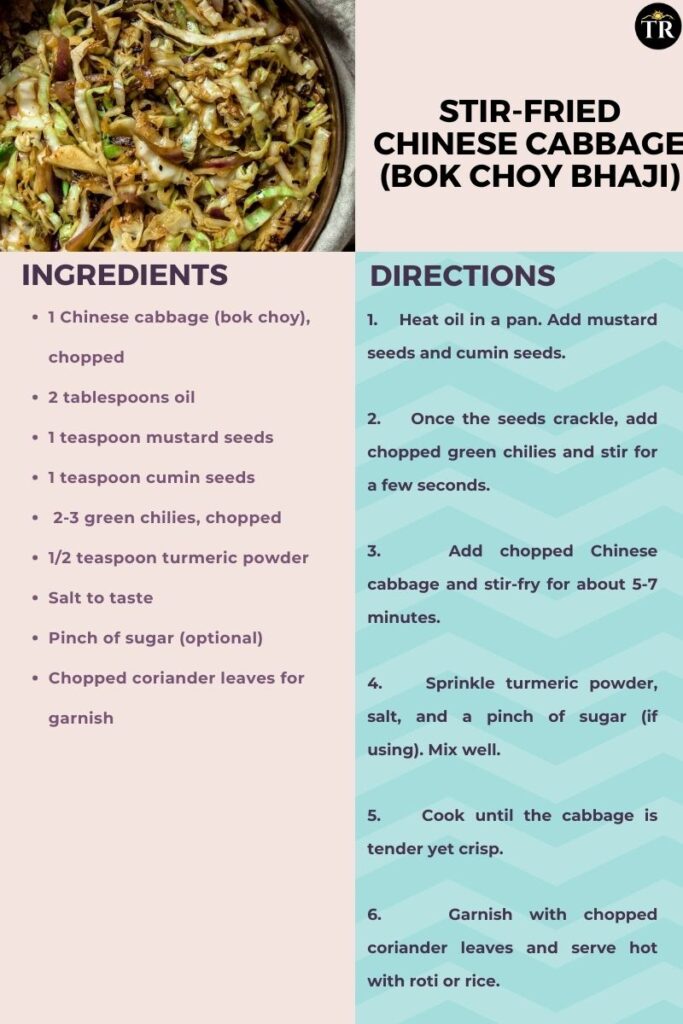
RECIPE 2] Chinese Cabbage Pakoras
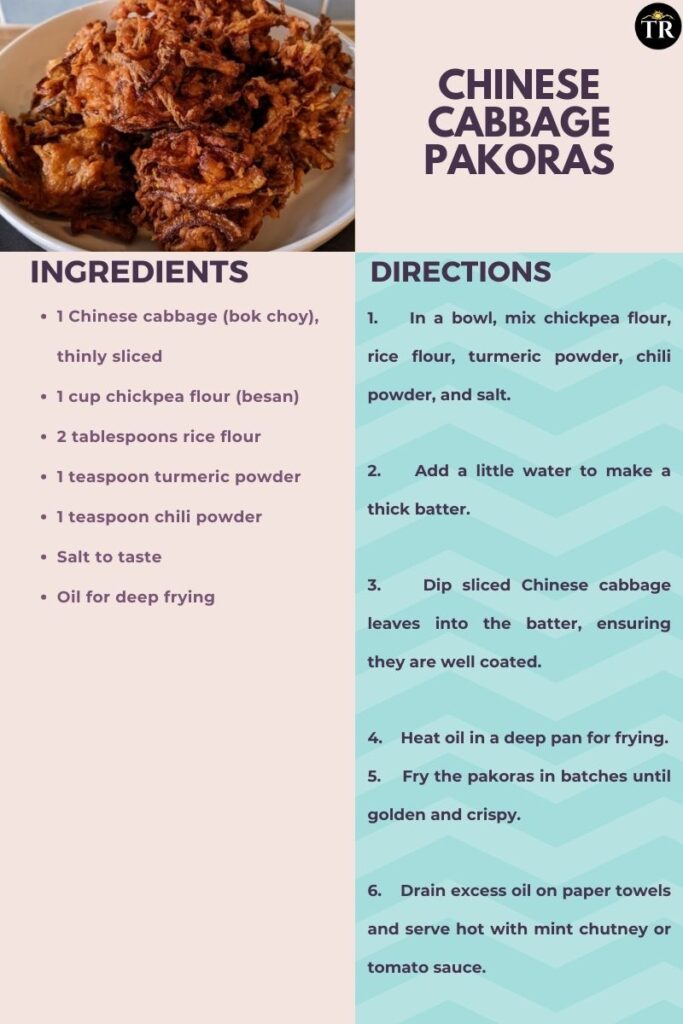
RECIPE 3] Chinese Cabbage Salad
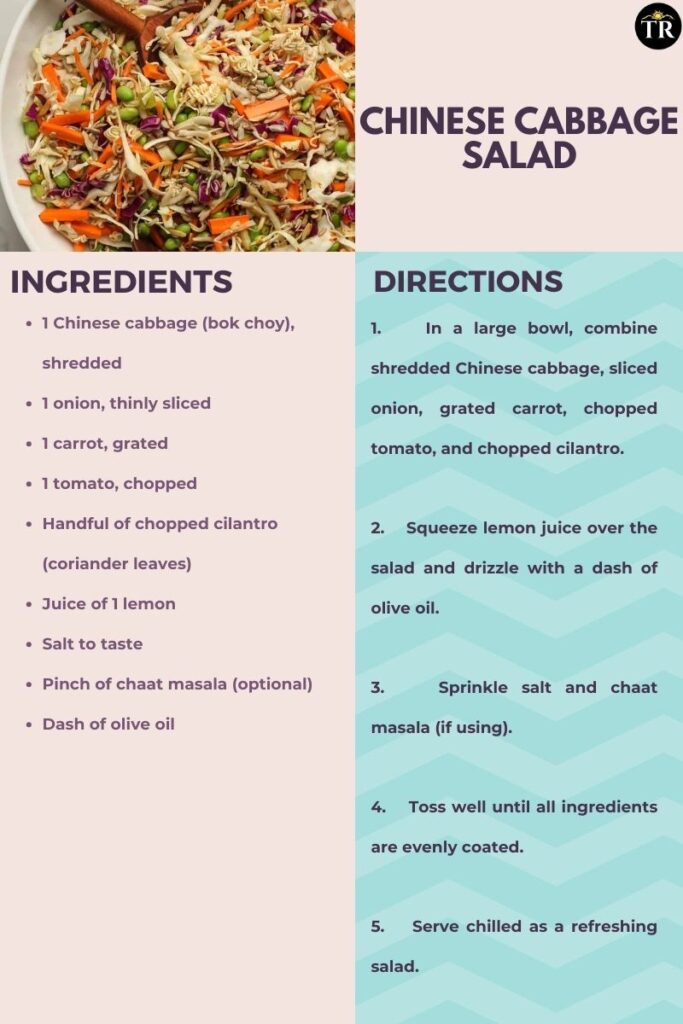
RECIPE 4] Chinese Cabbage Paratha
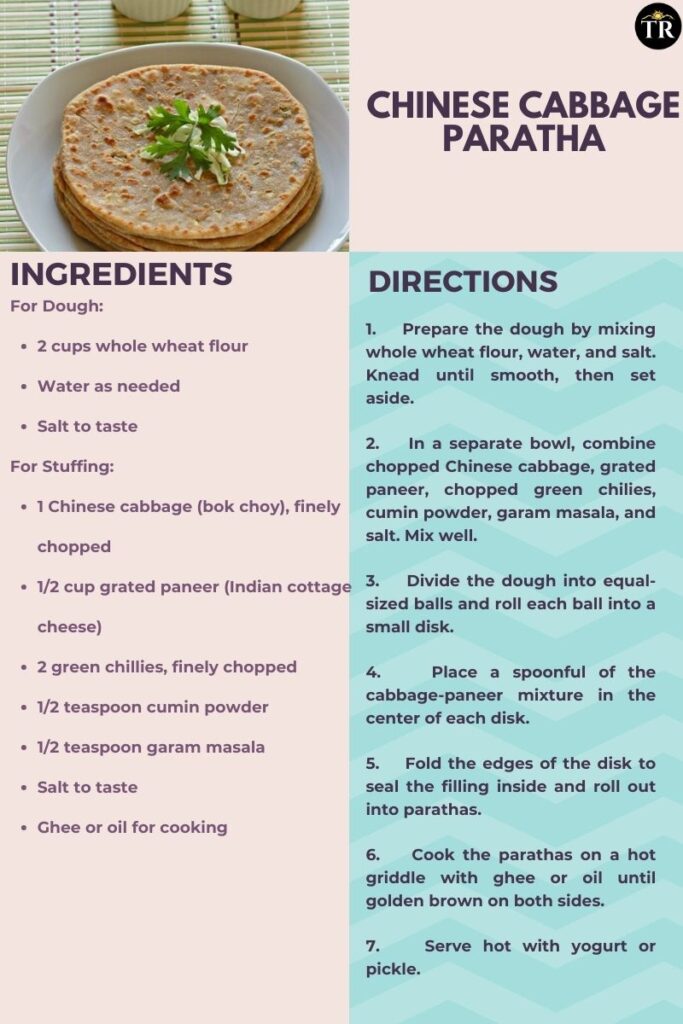
RECIPE 5] Chinese Cabbage and Lentil Soup
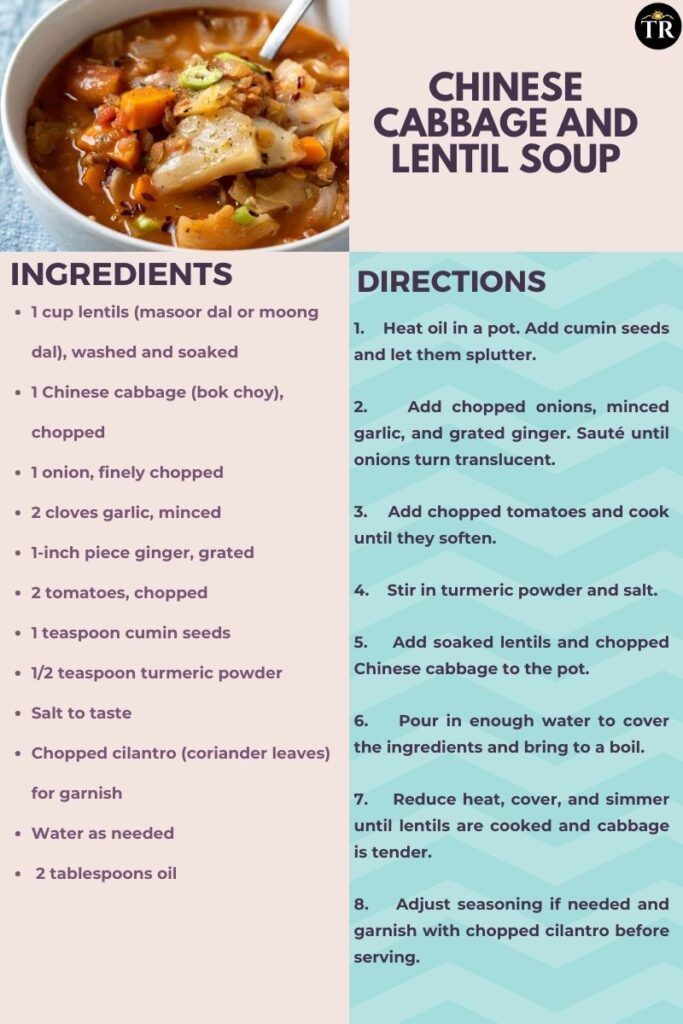
RECIPE 6] Chinese Cabbage Kimchi
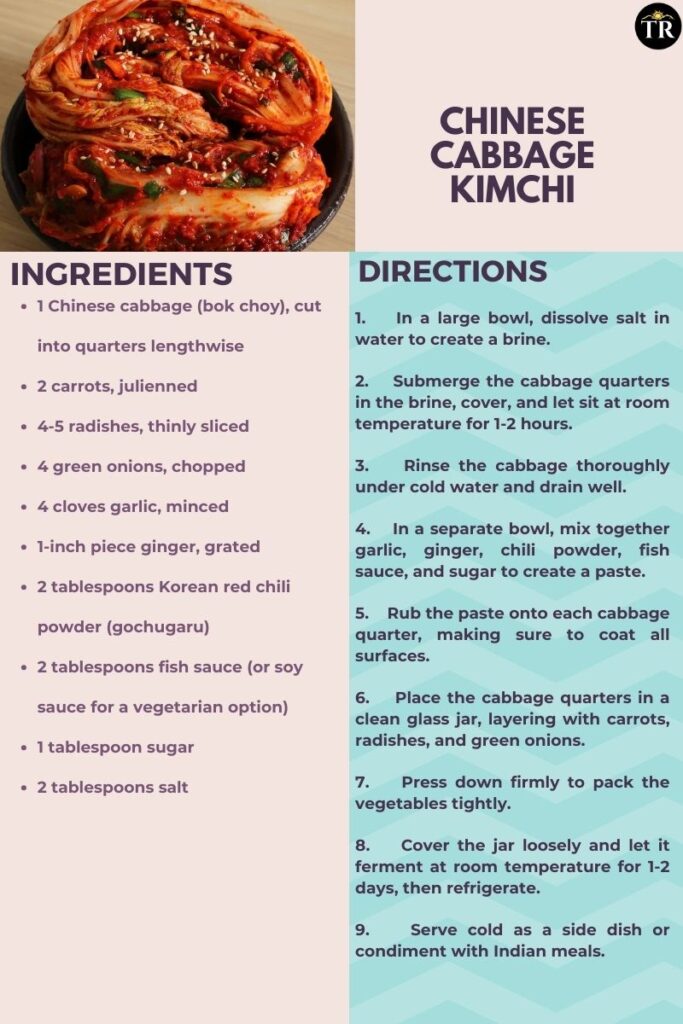
Conclusion
In conclusion, Chinese cabbage, also known as bok choy or pak choi, can be creatively incorporated into various Indian dishes, adding unique flavours, textures, and nutritional benefits. From stir-fries and pakoras to salads and soups, Chinese cabbage offers a versatile and healthy option for enhancing the taste and nutrition of traditional Indian recipes. Its mild flavour and crisp texture complement a wide range of ingredients and spices commonly used in Indian cooking. Whether you’re looking for a refreshing salad, a hearty soup, or a flavourful side dish, Chinese cabbage can be a delicious addition to your Indian kitchen repertoire. Experiment with these recipes and enjoy the fusion of Indian and Asian flavours that Chinese cabbage brings to the table.
Disclaimer: The views expressed in this article are of the author solely. TheRise.co.in neither endorses nor is responsible for them. Reproducing this content without permission is prohibited.
About the author
Dr. Kaviraj Khialani, celebrity master chef is a Mumbai based food and hospitality consultant. He is specialised in over 33 plus international cuisines & is a two times national award winner for his excellence in his field of expertise. Chef Kaviraj has worked with some of the reputed hotel chains & airline companies in India & Overseas. He is a renowned academician, food designer & author- writer on food and culinary features, besides having been featured on Colors Television & Star plus he loves trying global fusion cooking promoting Indian food on an international platter for the diaspora.

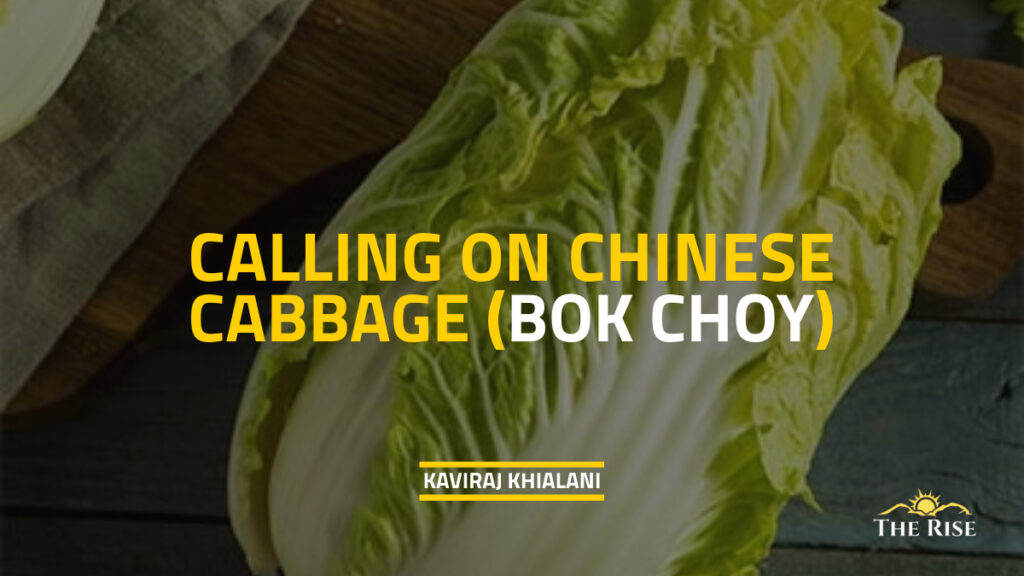









Pingback: VERMICELLI TREAT FOR PALATE - TheRise.co.in